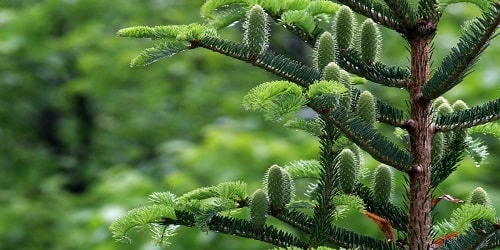Fir Meaning
The word fir has an uncertain etymological origin, possibly taken from the Aragonese “abete”. Another possibility is that it comes from “avet”, of Catalan origin.
The fir, or scientifically “Abies alba”, due to its white bark with an abundance of tannins, is an evergreen tree (evergreen) from humid climates, especially common in mountainous forests. It reaches fifty meters in height and has a pyramidal shape. The European mountains are its original area. It has a column-shaped trunk and its branches appear at the top.
Its flowering occurs in spring, its flowers dividing into cones, which are the female cones, and those where the pollen is located, which are the male cones.
It is similar to the pine, which belongs to the “pinus”, but although both are coniferous, we can easily distinguish them by the lighter color of their bark, which is smoother, in the case of the fir, and by their height, since that the pine does not measure more than 20 meters, while the fir can greatly exceed that height, reaching up to double it. The leaves of the fir, also in the shape of needles, do not prick like those of the pine and are shorter, and its cones do not fall to the ground.
“The Fir Tree” is a fairy tale from 1844, belonging to Hans Christian Andersen (1805-1875), where this tree, personified, dreams of growing and becoming an adult, but then realizes that time passes and it should have enjoyed the present when he was young, since after being decorated for Christmas, it loses its importance and is turned into firewood.
Fir Meaning in Hindi
फ़िर शब्द की व्युत्पत्ति अनिश्चित है, संभवतः इसे अरागोन के “एबेटे” से लिया गया है। दूसरी संभावना यह है कि यह कैटलन मूल के “एवेट” से आया है।
फ़िर, या वैज्ञानिक रूप से “एबिस अल्बा”, टैनिन की प्रचुरता के साथ अपनी सफ़ेद छाल के कारण, आर्द्र जलवायु से एक सदाबहार पेड़ (सदाबहार) है, विशेष रूप से पहाड़ी जंगलों में आम है। यह पचास मीटर की ऊँचाई तक पहुँचता है और इसका आकार पिरामिड जैसा होता है। यूरोपीय पहाड़ इसका मूल क्षेत्र हैं। इसका तना स्तंभ के आकार का होता है और इसकी शाखाएँ सबसे ऊपर दिखाई देती हैं।
इसका फूल वसंत ऋतु में खिलता है, इसके फूल शंकु में विभाजित होते हैं, जो मादा शंकु होते हैं, और वे जहाँ पराग स्थित होते हैं, जो नर शंकु होते हैं।
यह चीड़ के समान है, जो “पिनस” से संबंधित है, लेकिन हालांकि दोनों शंकुधारी हैं, हम उन्हें उनकी छाल के हल्के रंग से आसानी से पहचान सकते हैं, जो कि देवदार के मामले में चिकनी होती है, और उनकी ऊंचाई से, क्योंकि चीड़ 20 मीटर से अधिक नहीं मापता है, जबकि देवदार उस ऊंचाई से बहुत अधिक हो सकता है, जो इसे दोगुना तक पहुंचा सकता है। देवदार की पत्तियाँ, जो सुइयों के आकार की भी होती हैं, चीड़ की तरह चुभती नहीं हैं और छोटी होती हैं, और इसके शंकु जमीन पर नहीं गिरते हैं।
“द फ़िर ट्री” 1844 की एक परी कथा है, जो हंस क्रिश्चियन एंडरसन (1805-1875) से संबंधित है, जहाँ यह पेड़, मानवकृत, बढ़ने और वयस्क होने का सपना देखता है, लेकिन फिर उसे एहसास होता है कि समय बीत जाता है और उसे युवा होने पर वर्तमान का आनंद लेना चाहिए था, क्योंकि क्रिसमस के लिए सजाए जाने के बाद, यह अपना महत्व खो देता है और जलाऊ लकड़ी में बदल जाता है।
